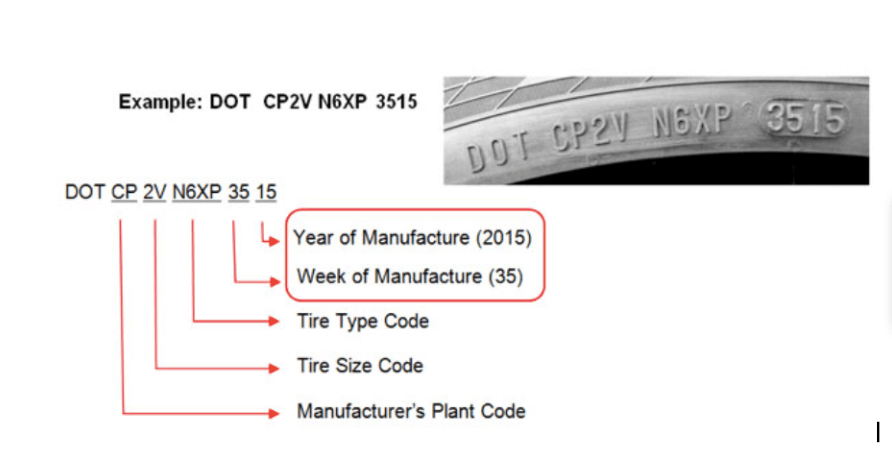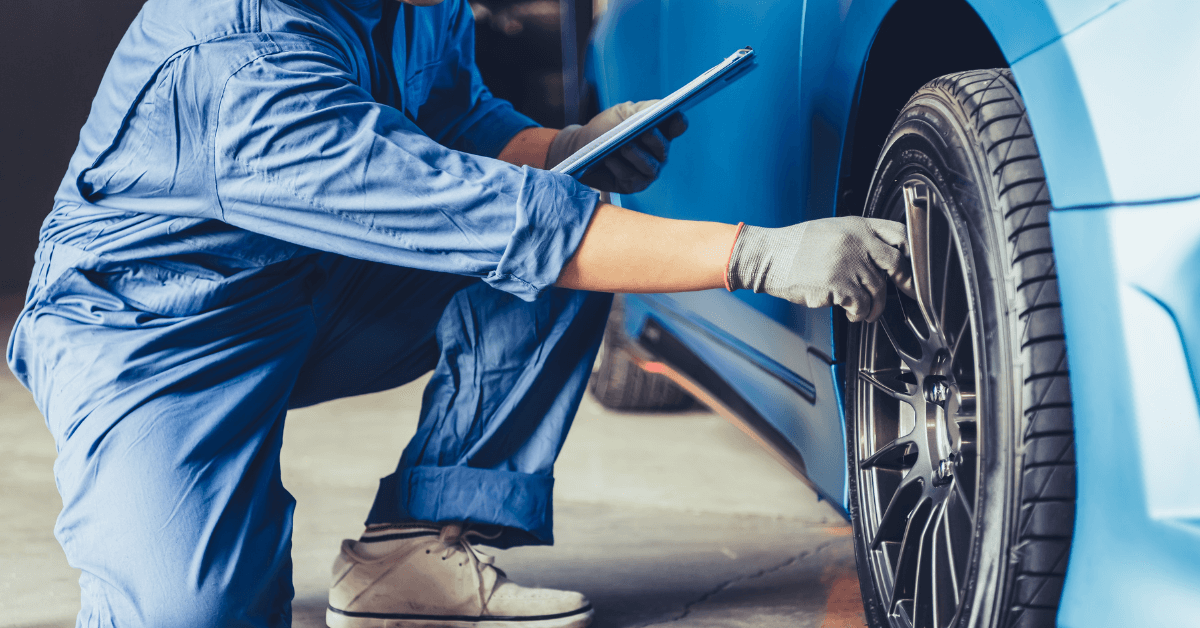How to Check Tyre Year- Decode The Expiry Date Of Car Tyres
A Quick Guide to Checking Tyre Year and Expiry Date

Find your tyre
READ THE DIMENSIONS OF TYRES

Your car tyres are more than just rubber; they are engineered products that break down as time passes. While you can see no tread wear, the tyre rubber is aging. Tyre makers use a standard code (the DOT code) to show when they are made. It helps car owners to check tyre size, expiry date, and tyre age and figure out the right time to swap them.
Even if the tyre tread looks good, the chemical composition of a tyre can break down, making it lose grip, which can lead to dangerous situations like blowouts or poor control in bad weather. This blog will share some tips on how to check your tyres year, why tyre age is required, the importance of tyre manufacturers' guidelines, and useful tips for choosing and checking tyres, with a focus on tyre laws in the UAE. Let us get into the details!
What is the Age of a Tyre?
Tyres get older no matter how often you use them. A bunch of things speed up their aging process, such as terrain, road conditions, extreme weather, and how you store them. So, here are some factors that make your car tyres weak over time:
- Material Deterioration: Rubber compounds break down over time, even when the tyre has minimal tread wear.
- Chemical Changes: Sunlight and harsh weather speed up the oxidation process, making the tyres dry, cracked, and weak.
- Safety Risks: Aging tires have a compromised structure, making them prone to blowouts or decreased grip during braking.
Note: Even when your tyre looks like it still has a lot of tread left, its old age might make it weaker. This can make your driving not as good. Therefore, manufacturers recommend tyre inspections after five years and replacement after ten years, irrespective of visible wear and tear.

How to Check Tyre Year?
Need to find out the tyre year? Simply look for the DOT numbers stamped on the tyre's sidewall. Get up close, and you will spot key details telling you when they made the tyre.
1. Firstly, locate the DOT Code by examining the sidewall of your tyre for the “DOT” marking. The DOT code has a bunch of letters and numbers, like this:
- The manufacturer’s factory code.
- The tyre size or type.
- A unique serial number.
- The tyre manufacturing date code is usually the last four digits.
2. Secondly, understand the DOT code. If a tyre was made after the year 2000, you will find a four-number code at the end of the DOT code.
- The initial pair of digits shows which week they made it in, any number between 01 and 52 because there are a total of 52 weeks in a year.
- The final pair of digits tells you the year they were manufactured.
Most of the modern tyres generally use the four-digit format. But, for the tyres made before the year 2000, the date code might be three digits.
For example, if the code says DOT XXXXXX3719, you have a tyre that was created in week 37 of the year 2019. So, with that info about the week and year, you can calculate how long your tyre has been in the market, even if it has been sitting in the storage spot for ages.
Do Tyres Have an Age Limit?
Tyres do not last forever. Rubber deteriorates with time, even when the treads are thick and do not look worn. Thus, tyre rubber can lose its efficiency and safety characteristics, leading to its aging. According to what the tyre makers suggest and for better safety, check out these signs that tell you that this is time to change the car tyre:
1. General Recommendations
Many tyre makers advise replacing your tyres after six years, no matter how much the tread has worn out. However, you need to get your tyres checked by an expert once every five years.
2. Maximum Lifespan
Some tyre experts suggest that tyres should not be used beyond ten years from the manufacturing date, even if they appear to be in good condition.
3. Usage Conditions
Exposure to extreme heat, sunlight, or poor storage conditions may speed up tyre ageing, thereby shortening its safe lifespan.
Note: Regulatory bodies in different areas have some set standards. In the UAE, the rules make it clear that tyres past a certain age cannot make it through inspection due to the harsh weather.
Do All Tyre Brands Use Similar Tyre Dating Methods?
Internationally, most well-known tyre brands display tyre manufacturing dates in a similar fashion. It is a standard procedure so that people get to know the tyre's year and related information printed on the tyre sidewall. You will find a series of numbers in the DOT (Department of Transportation) code. These numbers indicate both the specific week and the year the tyre was made. This information is mandatory for the performance and safety of a tyre.
How to Choose The Right Tyre for Your Car?
Choosing the right tyres is not just about getting the right size for your car, it is more than this. You need to take a closer look at several important details before you make your final decision:
1. Match the Tyre Size
Have a look at the tyre maker's manual, as it contains a list of the recommended tyre sizes for different cars. Now, have a look at the sidewall information to confirm that the tyre you are choosing matches the specifications of the current tyre printed on its sidewall, including its width, rim diameter, etc.
2. Consider Driving Conditions
In hot places such as the UAE, tyres face serious heat and need better heat resistance. Plus, pick tyres that match the roads you often roll on – be it the big highways, buzzing city streets or wild off-road tracks.
3. Look at Tread Design and Performance Ratings
Tyres with different tread designs are built for unique performances in wet or dry conditions. Further, do not forget to check the performance grades, as some tyres come with UTQG (Uniform Tire Quality Grading) ratings that tell you their treadwear, grip, and how well they can handle extreme heat.
4. Check the Tyre Manufacturing Date
Ideally, choose tyres with a recent manufacturing date (fresh stock). As tyres can sit in storage for long periods, older stock may already be part of the aging process, even if they’re new.
5. Price and Warranty
Check out tyres with a strong warranty that covers wear and tear, plus any factory defects. Sometimes, spending a bit more at the start can save you time, money, and trouble by getting a tyre that lasts longer.
How Many Years Should a Tyre Last?
Under the best circumstances, most car tyres should last 5 to 10 years. But many things can affect how long a tyre lasts. Here's a quick rundown to think about before you buy or replace a tyre:
- Tyre Lifespan: Under typical driving conditions and with proper maintenance, tyres should last about 5 to 10 years from the tyre manufacturing date.
- Tread Wear: Even when the tread looks fine, a tyre might still need replacement after 10 years because of aging and internal breakdown.
- Driving Habits and Road Conditions: Hitting the road more often during hot weather, driving on rough roads, and improperly inflated and misaligned tyres can greatly reduce the tyre life.
- Professional Inspections: A lot of tyre specialists suggest taking a look at your tyres every year once they are over five years old because it can reveal any weathering or other tyre flaws.
- Regular Rotation: Switching your tyres regularly helps them last longer by distributing the wear across all four tyres. Also, you won't find uneven tread wearing by doing this.

Why Regular Tyre Inspections Are Crucial?
Regular tyre inspections are important due to the following reasons:
- Blowout Prevention: Ageing tyres or those with internal damage may fail suddenly, leading to blowouts that can cause accidents.
- Better Grip: Over time, the loss of elasticity can reduce traction, especially in adverse weather conditions.
- Better Handling: The tyres that are in good condition always keep your car’s steering and stopping power up to the mark.
- Fuel Efficiency: Underinflated or worn tyres can impact the fuel efficiency of your car, increasing wear on other parts of the vehicle.
- Inspections: In the UAE, tyres must meet specific standards to pass vehicle checks. So, failing to comply may cause you penalties or overall inspection failure.
- Warranty Claims: Systematic tyre checks help track tyre status, which could prove helpful when pursuing warranty coverage or resolving vendor disputes.
- Preventing Accidents: Well-maintained tyres minimise crash risks, helping to avoid both monetary losses and personal trauma.
Tyre Expiry Date Regulations in the UAE
The UAE faces tough weather conditions that have a big effect on how tyres age and work. Because of this, the UAE has put these rules on the tyre expiry date using tyres:
- Maximum Age: As per UAE tyre regulations, tyres must be less than five years old from when they were made. Thus, officials check tyre manufacturing dates during vehicle inspections.
- Inspection Standards: When the Roads and Transport Authority (RTA) in the UAE or similar agencies check vehicles, cars with tyres that are too old or worn out fail the test.
- Weather Considerations: High temperatures accelerate tyre degradation, and thus, even tyres with adequate tread depth might not be safe if they are too old.
Tyre Expiry Date Checking Tips
Knowing how to check the expiry date of a tyre is important to ensure that your car remains safe and compliant with local regulations. Here are some useful tips to find out the expiry date of a tyre:
- DOT Code Check: At least once a year, make it a habit to check the DOT code on your tyres, especially if you frequently drive in harsh conditions. Note the manufacture date for each tyre and follow a regular tyre inspection routine.
- Sidewall Inspection: Look for visible signs of ageing, such as cracks, bulges, or dry rot on the tyre’s sidewall.
- Tread Wear: Look at the tyre tread pattern to make sure it is even. Also, keep an eye out for any spots that are wearing down more than others because it could mean you need a wheel alignment service.
- Annual Inspection: Even if your tyres look fine, have a car professional inspect them once a year after they reach five years of age.
- Service Centre Visits: Think about scheduling a tyre rotation and balance check. This car tyre service can also uncover hidden damage or wear you might not notice otherwise.
- Tyre Pressure Monitoring Systems (TPMS): Tyre Pressure Monitoring Systems, or TPMS, tell you whenever there is any change in the tyre pressure. So, when there is any issue with your car tyres, the TPMS alerts you to replace them or get them fixed.
- Storage and Environmental Conditions: If you leave your car outside or in direct sunlight, your car tyres might wear out faster. Thus, you need to check the tyres even if they are brand new. Also, if you drive in hot areas or on rough roads, it is a good idea to get them checked more often.
One-Stop Shop for Tyre Needs: TyrePlus
Explore the latest range of tyres by size, brand, and type at TyrePlus. Elevate your driving experience with our premium car services, tailored to keep your vehicle in optimal condition. With conveniently located branches across the UAE, TyrePlus offers free tyre inspections and expert sales support. Book your appointment online or visit your nearest TyrePlus center. Don’t miss out on our exclusive promotional offers for great deals on tyres and car repair and service.
Conclusion
Tyres of your car play a big role in keeping you safe on the road and making sure you get a comfy ride, but if they don't get the care they should, it can lead to poor vehicle handling, less traction, and other potential risks. Figuring out the tyre year and its expiry date and decoding the DOT code lets you handle your car really well. Even when a tyre's tread seems okay, its age might mess with the strength of the tyre as the rubber gets worse over time. However, checking your tyres often, storing them the right way, and replacing them when it is the right time all add up to a car ride that is both safe and smooth with excellent performance.
FAQ
What should I know before buying car tyres?
Before you buy fresh tyres, be sure to examine several factors. Look at their size, tyre year, specifications, and compatibility with your vehicle. See how old they are, their load-bearing capacity, and how fast they can go. Look into the warranty, what the tread looks like, and which company makes them.
